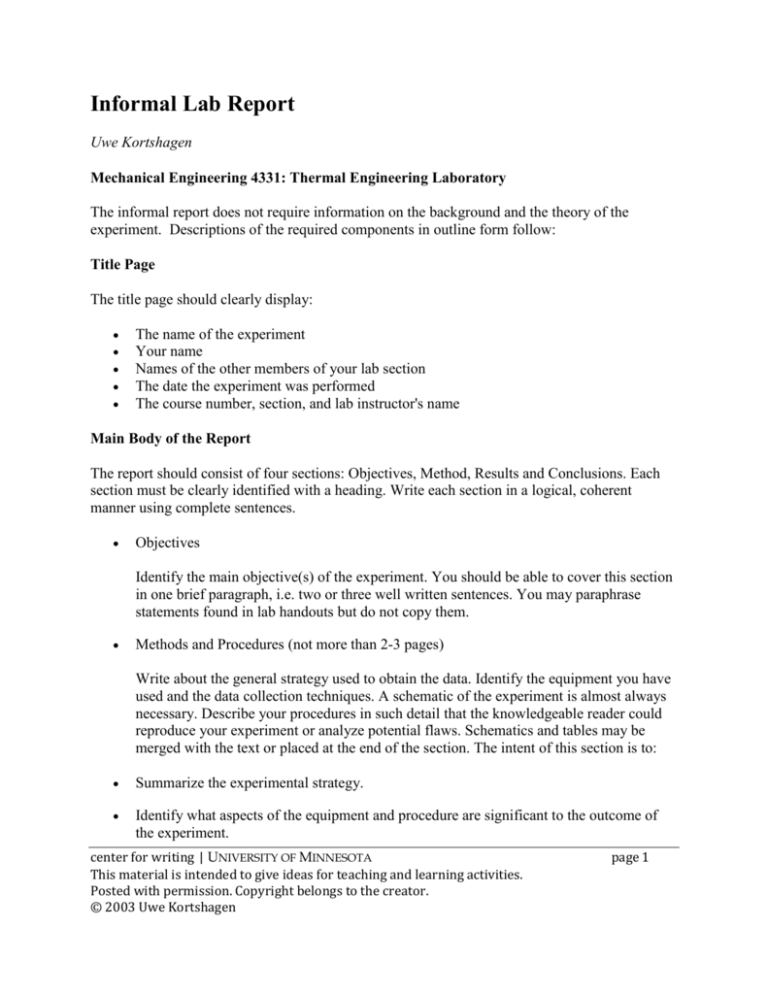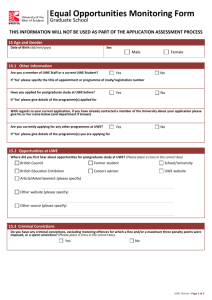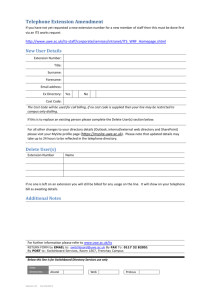Informal Lab Report - Center for Writing
advertisement

Informal Lab Report Uwe Kortshagen Mechanical Engineering 4331: Thermal Engineering Laboratory The informal report does not require information on the background and the theory of the experiment. Descriptions of the required components in outline form follow: Title Page The title page should clearly display: The name of the experiment Your name Names of the other members of your lab section The date the experiment was performed The course number, section, and lab instructor's name Main Body of the Report The report should consist of four sections: Objectives, Method, Results and Conclusions. Each section must be clearly identified with a heading. Write each section in a logical, coherent manner using complete sentences. Objectives Identify the main objective(s) of the experiment. You should be able to cover this section in one brief paragraph, i.e. two or three well written sentences. You may paraphrase statements found in lab handouts but do not copy them. Methods and Procedures (not more than 2-3 pages) Write about the general strategy used to obtain the data. Identify the equipment you have used and the data collection techniques. A schematic of the experiment is almost always necessary. Describe your procedures in such detail that the knowledgeable reader could reproduce your experiment or analyze potential flaws. Schematics and tables may be merged with the text or placed at the end of the section. The intent of this section is to: Summarize the experimental strategy. Identify what aspects of the equipment and procedure are significant to the outcome of the experiment. center for writing | UNIVERSITY OF MINNESOTA This material is intended to give ideas for teaching and learning activities. Posted with permission. Copyright belongs to the creator. © 2003 Uwe Kortshagen page 1 Results and Discussion Prepare graphs and tables that best display the results of the experiment and discuss them. Indicate trends, analyze why they occur, and explain any significant features or differences from expected results . Be as specific and quantitative as possible. Avoid the use of catch-all phrases such as "human error." Always comment on "wild" data points. Graphs and tables may be merged in the text or placed at the end of the section; either way, they must be numbered and referenced in the text. More detailed information on graphs is given below. Conclusions and Recommendations Present the conclusions you draw from the results. All conclusions should be clearly stated and supported with evidence. Cite specific results and observations from the experiment and tie them to your conclusions. Summarize reasons for any disagreement between your results and the expected results. Recommend ways to correct problems that may have led to discrepancies or bad data points. Graphs, Tables, and Figures These may appear in the Method or Results sections but are graded separately. Graphs and tables should be clear and logical. They should be free-standing and carefully labeled, such that the reader can understand them without referring to the text. Hence, you will have to choose figure captions and table titles carefully. In an informal report, you may use graph titles if you wish, but you must still number the figures and include complete captions. Note that "x vs y" or anything similar is rarely appropriate - captions and titles should be descriptive of the experiment. Each graph should be properly scaled and drawn using standard data symbols and curve drawing techniques. An example is given below; additional details and examples can be found in the document describing formal reports. You may merge the figures into the text or place them at the end of the respective sections. If you do the latter, the order of appearance of the graphs, tables, and figures should parallel the order of discussion. The text should reference the appropriate figures and tables by number rather than by title. center for writing | UNIVERSITY OF MINNESOTA This material is intended to give ideas for teaching and learning activities. Posted with permission. Copyright belongs to the creator. © 2003 Uwe Kortshagen page 2 Example graph: Appendices The following appendices should be included in each of the informal laboratory reports for this course: o Original Data Sheets (or diskettes in the event of voluminous data) o Sample Calculations: a sample calculation must be included for equations used in data reduction. These may be neatly written out by hand or be done with a word processor. Carry the sample calculations through using the same data point throughout. Include the following: 1. 2. 3. 4. 5. 6. A label identifying the calculation. Statement of the equation in symbolic form. Identification of variables (include units). Sufficient description that the readers can follow your work. Substitution of one set of numbers. Carry the units and USE THEM!!! An example is shown below: Heat Transfer Coefficient h = q/(Ts - To ) h = heat transfer coefficient (W/m2°C) q = heat flux (W/m2) Ts = surface temperature (°C) To = ambient temperature (°C) using numbers from the first data point: h = (100)/(60-20) = 2.5 W/m2°C center for writing | UNIVERSITY OF MINNESOTA This material is intended to give ideas for teaching and learning activities. Posted with permission. Copyright belongs to the creator. © 2003 Uwe Kortshagen page 3 Do not include computations for every single data point. This gets messy and hard to follow. Submission of a spreadsheet handout will not fulfill the requirements for this section. If a computer program is a significant part of the pre-lab effort, a program listing should also be included as an appendix. Additional Notes: Reports will be graded largely on their ability to clearly communicate results and important conclusions to the reader. It is important that you use proper English, spelling, logic and style. You should proofread your report as well as spell-check it - errors such as "Diesel fuel infection" and "Untied States" are amusing but not impressive. o o o o Neatness and organization will also influence the grade a report receives. Be sure to follow explicitly the format indicated above. It is now required to type reports, and attach lab notes as appendices. Avoid being overly verbose and flowery when attempting to convey your point be concise. The previous sentence is an example of both forms. Avoid qualitative phrases such as "the results were quite close" or "heat fluxes were in good agreement with the correlation." Be as quantitative as possible. Do not copy material without citing the source. This includes lab manuals, text books, your neighbor, old labs, etc. Plagiarism, of any degree, will not be accepted; you will be asked to redo the report and docked accordingly. Kortshagen, Uwe . Informal Lab Report, Mechanical Engineering 4331: Thermal Engineering Laboratory, University of Minnesota. 14 Feb. 2003. center for writing | UNIVERSITY OF MINNESOTA This material is intended to give ideas for teaching and learning activities. Posted with permission. Copyright belongs to the creator. © 2003 Uwe Kortshagen page 4





